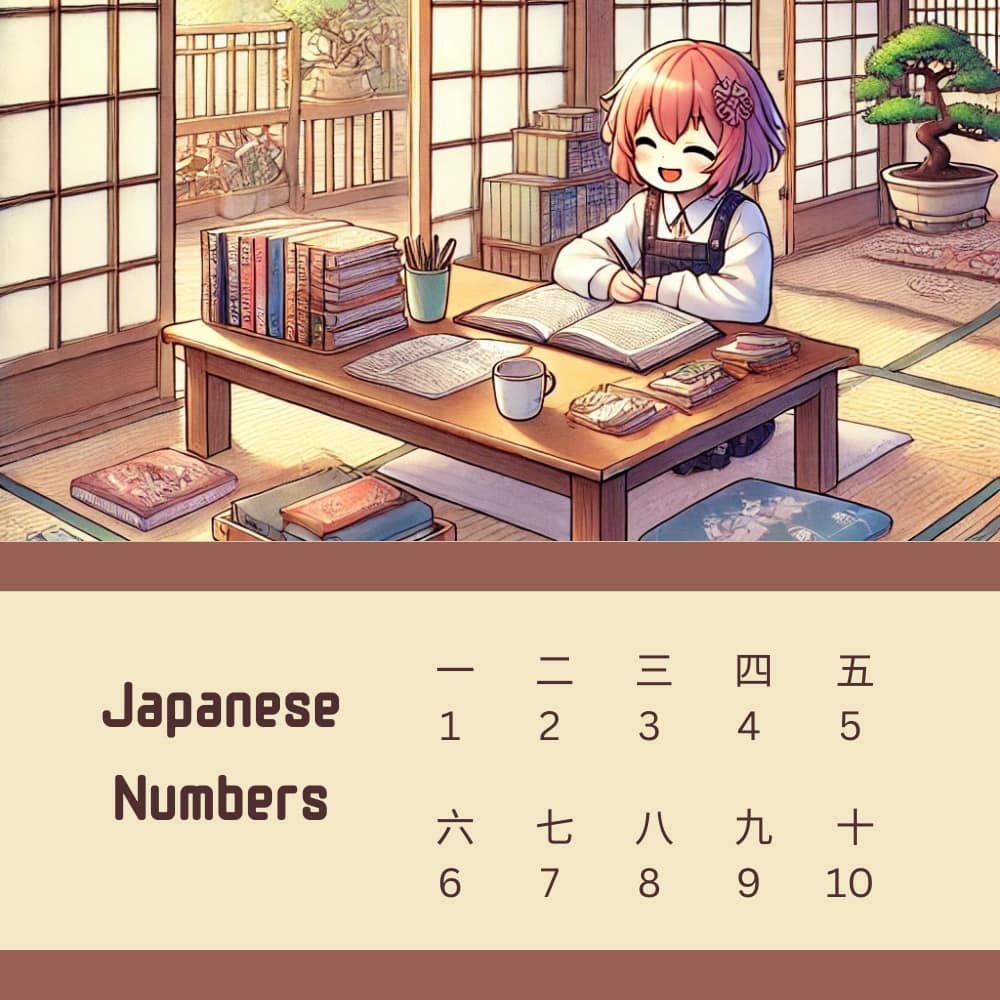Numbers are the backbone of every language, and in Japanese, they hold a fascinating blend of simplicity and complexity. Whether you’re learning Japanese for travel, work, or just for fun, understanding numbers is an essential step. In this guide, we’ll break down Japanese numbers, from their structure to their cultural quirks. By the end, you’ll feel confident counting and using numbers like a pro!
This blog will help you:
- Learn how Japanese numbers work (yes, including the tricky parts).
- Master counting from 1 to 100 and beyond.
- Dive into how numbers are used in daily life and Japanese culture.
Ready? Let’s get started!

How Japanese Numbers Work: A Quick Overview
Japanese numbers are primarily based on the Chinese numerical system, incorporating kanji characters for each digit. They’re logical and systematic, but they also come with some fun quirks.
- Basic Digits: The Japanese number system is decimal-based, just like English.
- Kanji Characters: Numbers 1-10 each have their own kanji symbol.
- Two Pronunciations: Each number often has two readings – one based on Chinese readings (onyomi) and one from native Japanese readings (kunyomi).
| Number | Kanji | Reading (Romanized) |
|---|---|---|
| 1 | 一 | ichi |
| 2 | 二 | ni |
| 3 | 三 | san |
| 4 | 四 | shi/yon |
| 5 | 五 | go |
| 6 | 六 | roku |
| 7 | 七 | shichi/nana |
| 8 | 八 | hachi |
| 9 | 九 | ku/kyuu |
| 10 | 十 | juu |
Counting Beyond 10: The Systematic Beauty of Japanese Numbers
Here’s where it gets fun! Japanese numbers are built by combining simpler numbers into larger ones.
- 11-19: Combine “10” (juu) with the smaller numbers.
- Example: 11 = juu + ichi = juuichi
- 20, 30, etc.: Use multiples of 10 (ni-juu, san-juu).
- Example: 30 = san + juu = sanjuu
- Hundreds: The word for “hundred” is hyaku.
- Example: 300 = san + hyaku = sanbyaku
- Thousands: The word for “thousand” is sen.
- Example: 2000 = ni + sen = nisen
Watch Out for Exceptions!
- The pronunciation of numbers can change for smoother speech, especially when combined. For example:
- 300 = sanbyaku (not sanhyaku)
- 600 = roppyaku (not rokuhyaku)
Cultural Insights: Numbers in Japanese Society
Numbers in Japan are more than just tools for counting – they carry deep cultural meanings. Some numbers are considered lucky, while others are outright avoided because they sound like words with negative connotations.
Lucky Numbers:
- 8 (八, hachi): The shape of the kanji widens at the base, symbolizing growth and prosperity.
- 7 (七, nana): Associated with good fortune and happiness.
Unlucky Numbers:
- 4 (四, shi): Sounds like “death” (死, shi) in Japanese.
- 9 (九, ku): Sounds like “suffering” (苦, ku).
Because of these beliefs, it’s common to see certain numbers skipped in hospital rooms, phone numbers, and even apartment floors!
Everyday Use of Japanese Numbers
Once you’ve nailed the basics, you’ll notice how often numbers pop up in everyday Japanese life. Here are a few key examples:
Dates and Time:
- Dates: Use the format year-month-day (e.g., 2024年12月8日 = 2024-12-08).
- Time: Hours are counted with the suffix 時 (ji), while minutes use 分 (fun/pun).
- Example: 3:30 = sanji han
Money:
Japan’s currency, the yen (円, en), uses numbers extensively.
- Example: 500 yen = gohyaku en
Counting Objects:
Japanese numbers also pair with counters, which are specific words used to count different types of objects.
- 人 (nin): For people (e.g., 三人 = sannin = 3 people)
- 本 (hon): For long, cylindrical objects (e.g., 二本 = nihon = 2 pencils)
Quick Tips to Master Japanese Numbers
Learning numbers can feel overwhelming, but these tips will make it a breeze:
- Start Small: Focus on 1-10 first before moving on to larger numbers.
- Practice Aloud: Japanese numbers have specific pronunciations that are easier to remember when spoken.
- Use Real-Life Scenarios: Practice with dates, prices, or counting objects around you.
- Learn the Counters: Start with common ones like nin (people), mai (flat objects), and hon (long objects).
If you’re learning Japanese, understanding how to express numbers is a crucial step. Japanese numbers not only play a significant role in daily conversations but are also essential when discussing dates, times, and prices. Converting numbers to Japanese might feel tricky at first, but with the right tools, it becomes a breeze. For a quick and easy way to convert numbers into Japanese characters, check out this Japanese Number Converter. It’s a super handy resource for learners and anyone curious about Japanese numerals!
FAQs About Japanese Numbers
Q: Why are there multiple pronunciations for some numbers?
A: This stems from Japanese adopting Chinese characters (kanji) centuries ago. The two pronunciations – Chinese-based (onyomi) and Japanese-native (kunyomi) – coexist today.
Q: Are Japanese numbers hard to learn?
A: Not at all! The system is logical, and with a bit of practice, you’ll pick it up quickly.
Q: Do I need to know kanji to count in Japanese?
A: While it’s helpful, it’s not essential. You can get by with the Romanized versions (romaji) or the hiragana readings.
Wrapping Things Up
Numbers in Japanese are more than just a tool for math – they’re a gateway into understanding the language’s logic, culture, and quirks. From lucky and unlucky numbers to unique counters for objects, there’s a lot to explore.
Whether you’re a beginner or brushing up on your skills, this guide will give you a strong foundation. So, grab a notebook and start counting – you’ve got this!